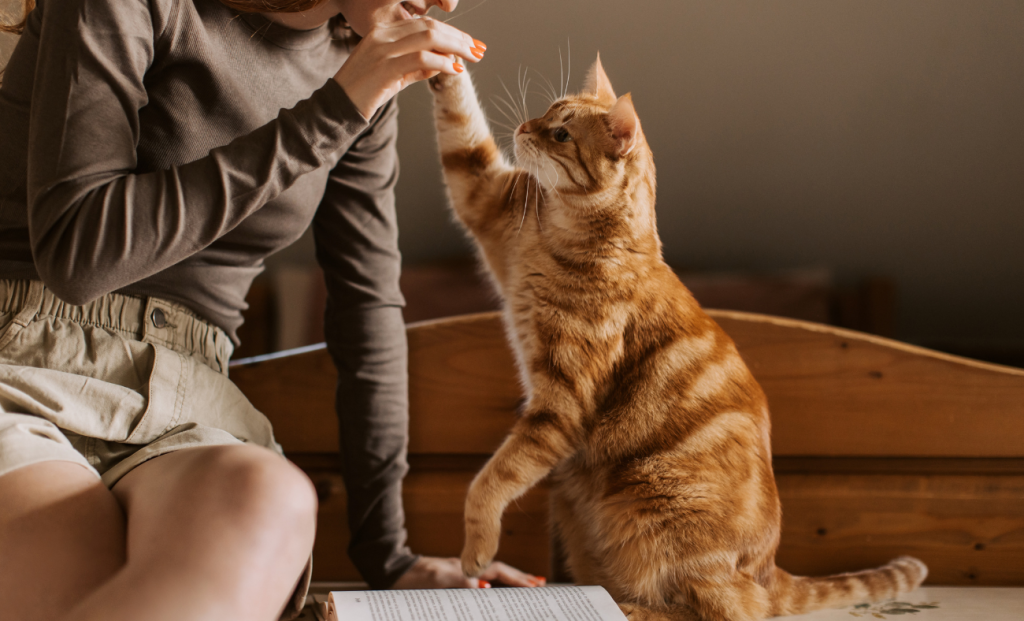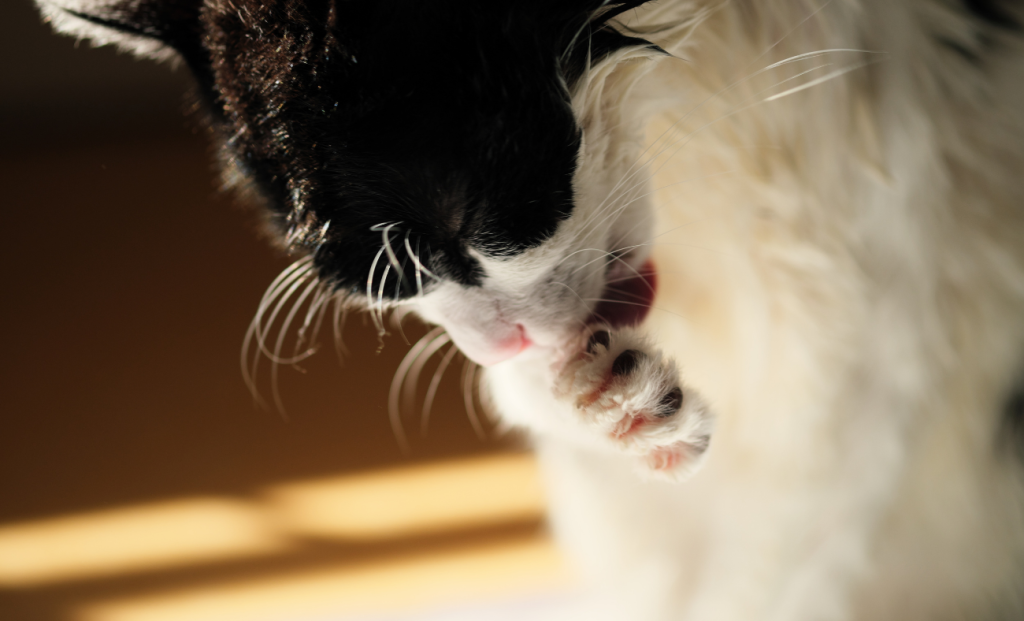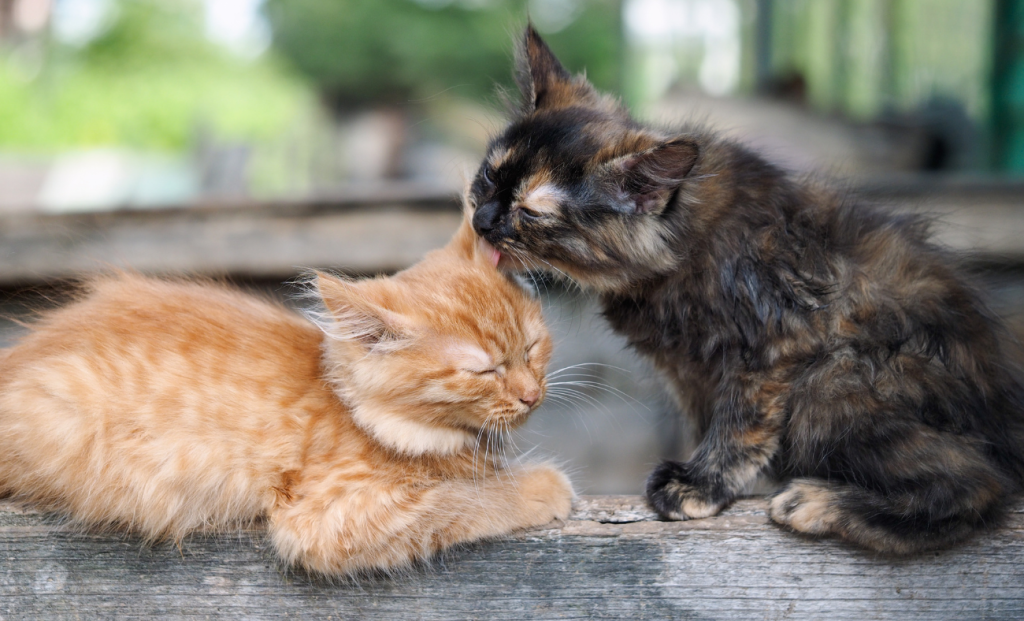I used to think all meticulous grooming was adorable. Until I learned what anxiety actually looks like in felines.
Imagine you’re curled up on the couch watching what you think is the epitome of feline self-care. Your cat methodically working through their grooming routine, each lick deliberate and thorough. “Look how clean they keep themselves,” you’d think with that warm pride every cat parent feels watching their companion’s natural elegance.
What you might not know – what most cat parents never realize – is that this same grooming behavior you’re admiring could be one of the hidden cat stress signs, their way of screaming for help.
The revelation came during my studies in feline anxiety. As I learned about the biological mechanisms that cause anxiety in cats, everything clicked into place. That “adorable” grooming we see? It isn’t always self-care. Sometimes it’s self-medication.
When Perfect Grooming Becomes a Prison
Picture this scenario: You start noticing your cat grooming more than usual. At first, you’re pleased. “What a clean cat,” you think. But then you begin seeing things that don’t quite add up. The way they return to the same spot multiple times during a single grooming session. How their tongue movements seem more urgent than purposeful. That small patch on their inner thigh where the fur seems thinner than everywhere else.
These aren’t random observations. They’re pieces of a puzzle that reveals something profound about feline anxiety communication.
Cats experience their world so differently from us. While you see a clean, well-maintained cat, they might be trapped in a cycle where grooming has become their only escape from overwhelming feelings.
The Biology Behind the Obsession
Here’s what we know about cat anxiety grooming: when cats lick themselves, their brains release natural opioids. These chemicals provide genuine relief from anxiety, creating a neurochemical reward system that can become compulsive when cats feel overwhelmed.
Think about that for a moment. Your cat isn’t choosing to be obsessive about grooming. Their brain is literally rewarding them for this behavior every single time they feel stressed. It’s not willpower or personality. It’s biochemistry.
This explains so much about what cat parents often observe. The increased grooming after household changes. The way cats seem almost frantic during certain sessions. The difficulty they seem to have stopping once they’ve started.
When you understand the science behind this behavior, everything about your cat’s grooming patterns takes on new meaning. That extra attention to their paws after you’ve rearranged furniture? That’s not vanity. That’s neurochemical stress relief.

Recognizing the Subtle Escalation
Most cat parents miss feline stress grooming because it develops gradually. One day you notice your cat grooming a bit more. A few weeks later, maybe there’s a small bald patch. By the time you realize something’s wrong, the behavior has become deeply ingrained.
The progression typically follows a predictable pattern. Initially, you might notice slightly longer grooming sessions. Your cat seems to take more time with their daily maintenance routine. This feels normal, even admirable.
Then the frequency increases. Where your cat used to have distinct grooming periods, they now seem to groom more throughout the day. Brief, purposeful sessions become extended, repetitive activities.
The location patterns change too. Normal grooming rotates through different body areas systematically. Stress grooming becomes fixated on specific spots that provide maximum tactile comfort and neurochemical relief.
Learning to watch for these early warning signs helps distinguish normal grooming from anxiety-driven grooming in cats. Normal grooming is efficient and purposeful. Stress grooming is repetitive and seems disconnected from actual cleanliness needs.
The Physical Evidence We Often Dismiss
That small bald patch you might attribute to “seasonal shedding”? It could actually be evidence of your cat over-grooming. The slightly irritated skin you blame on dry air might be friction damage from repetitive licking. The way certain areas of your cat’s coat look different from others isn’t always natural variation – it could be wear patterns from anxious grooming.
Cat stress grooming typically targets specific body areas that cats can easily reach and that provide satisfying tactile feedback. Inner thighs, belly, front legs, and the base of the tail become common targets because the sensation of grooming these areas provides maximum stress relief.
As the behavior progresses, these areas show increasingly obvious signs of damage. Hair becomes thin and broken. Individual strands look shorter and more brittle than fur in other areas. The texture changes from soft and full to rough and sparse.
Skin may appear pink or irritated from constant moisture and friction. In severe cases, cats can create open sores from persistent licking. The skin becomes sensitive and may feel warm to the touch compared to unaffected areas.
The progression from normal grooming wear to obvious over-grooming damage often happens so gradually that cat parents don’t recognize the significance until the physical evidence becomes undeniable.
Understanding the Emotional Triggers
What fascinates many people is learning about the environmental factors that trigger feline stress grooming. These aren’t dramatic changes – they’re subtle shifts that barely register to us but feel enormous to cats’ anxiety-sensitive nervous systems.
New furniture arrangements can trigger grooming episodes. The scent of unfamiliar cleaning products creates environmental uncertainty. Changes in household schedules disrupt the predictability that cats rely on for emotional security. Even something as minor as moving their food bowl to a different location can create enough uncertainty to increase grooming behavior.
Consider how sensitive cats are to environmental changes compared to humans. Their hearing detects sounds we can’t perceive. Their sense of smell is fourteen times stronger than ours. Their vision processes movement and light changes differently than human vision.
From a cat’s perspective, what seems like a minor household adjustment represents a significant alteration to their sensory environment. When multiple small changes accumulate, the stress load can become overwhelming enough to trigger compensatory behaviors like excessive grooming.
Multi-cat households face additional challenges because cats may compete for resources or feel territorial pressure that manifests as stress grooming. One cat’s anxiety can actually trigger altered grooming behaviors in other household cats, creating a cycle of stress that affects everyone.
The Hidden Costs of Chronic Stress
Learning about the health impacts of chronic cat anxiety reveals why addressing stress grooming matters beyond just the physical damage. Cats experiencing ongoing stress show compromised immune function, digestive issues, and overall health decline that affects their quality of life in ways we often don’t connect to their emotional state.
The stress hormones that drive compulsive grooming also affect sleep patterns, appetite, social interaction, and even litter box habits. What appears to be an isolated grooming problem often indicates broader anxiety that requires comprehensive environmental assessment. Understanding these signs of stressed cat behavior helps identify when grooming has crossed the line from maintenance to stress management.
Chronic stress affects the digestive system by altering gut bacteria, affecting nutrient absorption, and creating digestive sensitivity that can lead to vomiting, diarrhea, or appetite changes. These secondary symptoms often develop weeks or months after the initial stress grooming begins.
Sleep patterns become disrupted when cats rely heavily on grooming for stress management. They may spend more time grooming during normal rest periods, leading to insufficient sleep and increased daytime fatigue that further compromises their stress resilience.
Cats who rely on grooming for stress management may become increasingly socially withdrawn, spending more time alone with their grooming routines and less time engaging with their families. This isolation can worsen their anxiety, creating a cycle that becomes harder to interrupt over time.

The Difference Between Normal and Anxious Grooming
Normal grooming serves specific purposes: removing loose fur, distributing natural oils, regulating body temperature, and maintaining hygiene. These sessions are typically brief, efficient, and followed by other activities like playing, eating, or resting.
Anxious grooming looks distinctly different. Sessions last longer than necessary for cleanliness. Cats return repeatedly to the same areas during single grooming episodes. The movements may seem frantic or urgent rather than methodical. Most tellingly, anxious grooming often occurs in response to specific triggers rather than as part of natural maintenance routines.
The timing patterns differ significantly too. Normal grooming typically occurs after meals, upon waking, or before sleep as part of natural daily rhythms. Feline stress grooming happens in response to environmental changes, during household activity, or when cats feel overwhelmed by their circumstances.
The body language during grooming also differs significantly. Relaxed grooming includes comfortable positioning, soft muscle tension, and normal breathing patterns. Cats may purr softly during normal grooming sessions, indicating contentment and relaxation.
Stress grooming often involves tense body posture, rapid breathing, and positioning that allows for quick environmental monitoring rather than relaxed focus on the grooming activity. Cats may appear hypervigilant during stress grooming, frequently pausing to scan their environment.
Environmental Factors That Fuel the Cycle
Understanding what triggers stress grooming helps identify the environmental factors that contribute to feline anxiety. Household noise levels, traffic patterns, resource accessibility, and territorial security all play roles in stress management.
Changes in routine create particularly strong grooming triggers. Cats thrive on predictability, and when their environment becomes uncertain, grooming provides a controllable, predictable activity that offers comfort when everything else feels chaotic.
The placement and accessibility of resources also affects grooming behavior. Cats who feel uncertain about their access to food, water, litter boxes, or safe resting areas may use grooming as a stress outlet when resource security feels threatened.
Lighting changes can trigger stress responses that manifest as increased grooming. Cats who are sensitive to seasonal light variations, new light fixtures, or changes in natural light patterns may develop compensatory grooming behaviors.
Sound sensitivity affects many cats more than their families realize. Air conditioning units, appliances, traffic noise, or construction sounds can create ongoing low-level stress that accumulates until cats need to increase their grooming to manage their stress.
Social Dynamics and Grooming Stress
In households with multiple cats, social pressure can significantly increase stress grooming behaviors. Cats may feel territorial pressure around resources, experience social hierarchy stress, or simply feel overwhelmed by too much social interaction in their living space.
Competition for preferred sleeping areas, feeding locations, or litter box access creates ongoing tension that many cats manage through increased grooming. Even when competition isn’t obvious to human observers, cats may feel pressure around resource sharing that requires stress management.
Even in single-cat households, human family stress can trigger increased grooming. Cats are remarkably sensitive to household emotional energy, and they often respond to family tension or schedule disruptions with increased self-soothing behaviors.
The social aspect of grooming itself can become problematic when cats begin using it to avoid interaction rather than maintain hygiene. Cats who spend increasing amounts of time grooming may be communicating that social interaction feels overwhelming and grooming provides necessary emotional regulation. Some cats may even develop abnormal cat hiding behaviors alongside excessive grooming as they seek additional ways to manage environmental stress.
Breaking the Cycle Without Breaking the Cat
The key to addressing feline stress grooming isn’t trying to stop the behavior directly – it’s addressing the underlying anxiety that makes excessive grooming feel necessary. Interrupting grooming without addressing the root causes often increases anxiety and can lead to other stress behaviors.
Environmental enrichment plays a crucial role in providing alternative stress outlets. Puzzle feeders engage cats’ hunting instincts and provide mental stimulation that can redirect nervous energy. Interactive toys offer physical activity that naturally reduces stress hormone levels. For some cats, cat anxiety natural remedies like environmental pheromones can support this enrichment strategy.
Vertical spaces give cats control over their environment and provide elevated security that can reduce overall anxiety levels. Hiding areas offer retreat options when environmental stimulation becomes overwhelming.
Creating predictable routines helps reduce the environmental uncertainty that often triggers cat stress grooming. Consistent feeding schedules, regular interaction times, and stable household patterns provide the security that anxious cats need to feel safe without constant self-soothing. Learning how to calm a stressed cat often starts with these fundamental routine adjustments.
The Role of Patience in Recovery
Addressing cat stress grooming requires patience because the behavior often serves important emotional functions that can’t be removed suddenly without providing alternatives. Cats need time to develop confidence in environmental changes and trust that their new routine will remain stable.
Recovery isn’t always linear. Cats may show improvement for days or weeks before having grooming episodes during times of environmental stress. This doesn’t represent failure – it demonstrates that grooming remains an available coping mechanism during particularly challenging periods.
Building long-term emotional resilience involves gradually expanding cats’ comfort zones while maintaining enough environmental security that they don’t feel constantly pressured to manage stress through grooming.
Some cats show rapid improvement when environmental triggers are addressed, while others require months of consistent environmental optimization before showing significant behavior changes. Individual personality, genetics, and past experiences all influence recovery timelines.
Prevention: Creating Environments That Support Natural Grooming
The most effective approach to cat stress grooming is prevention through environmental design that supports cats’ natural stress management abilities. This means creating homes where cats feel secure enough that grooming remains a choice rather than a necessity.
Providing multiple resources in different locations reduces resource competition and territorial stress. Multiple water stations, feeding areas, and litter boxes ensure that cats never feel uncertain about resource access.
Offering various resting areas, hiding spots, and vertical spaces gives cats control over their environment and social interaction levels. Cats need options for both social engagement and solitary retreat based on their individual needs and daily stress levels.
Understanding individual cat personalities helps create customized environments that support each cat’s specific stress management needs. Some cats require more social interaction, while others need additional privacy and independence.

Monitoring Progress and Building Confidence
Successful stress grooming intervention requires ongoing monitoring of both grooming behaviors and overall stress indicators. Improvements in grooming patterns often coincide with improvements in appetite, sleep quality, social interaction, and general confidence.
Environmental modifications may need adjustment as cats’ stress levels change and their confidence improves. What works during initial recovery may need refinement as cats develop better stress management skills.
Building cats’ confidence in their environment creates long-term resilience that prevents stress grooming recurrence during future environmental changes or household disruptions.
Your Cat’s Path to Healthy Grooming
Recognizing the difference between self-care and self-medication through grooming empowers cat parents to support their companions’ emotional wellness before grooming becomes a compulsive stress response.
When grooming becomes excessive, repetitive, or causes physical damage, it’s often a cat’s way of communicating that something in their environment requires adjustment to support their emotional needs. Understanding these cat anxiety symptoms opens the door to creating genuine wellness rather than simply managing problematic behaviors.
Every cat deserves to experience grooming as the pleasant, natural activity it’s meant to be rather than as their primary tool for managing overwhelming anxiety. With understanding, patience, and systematic environmental support, cats can rediscover the joy of grooming for its intended purpose rather than as desperate stress relief.
Ready to decode what your cat’s grooming patterns are really telling you about their emotional state? Download our FREE Cat Stress Assessment Checklist: The Essential 12 Hidden Signals to systematically assess your cat’s grooming behaviors and environmental stress factors, creating the foundation for emotional wellness that supports natural, healthy self-care rather than anxiety-driven stress relief.
